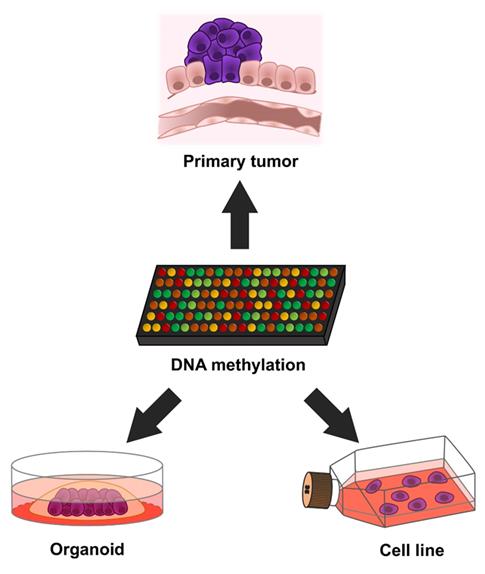Cancer research breakthrough as DNA behavior is uncovered in 3D models

Scientists have used 3D models to break down the DNA behavior of cancer cells, in a breakthrough new study which could revolutionize treatment for the disease. Credit: Dr Manel Esteller
Scientists have used 3D models to break down the DNA behavior of cancer cells, in a breakthrough new study which could revolutionize treatment for the disease.
In what is a first for science, a research team led by Dr Manel Esteller, Director of the Josep Carreras Leukaemia Research Institute (IJC), demonstrated how 3D models (known as organoids) can now be used to develop a characterization of the DNA make-up – or the epigenetic fingerprint – of human cancer.
Pubished in Epigenetics, the research validates the use of these 3D samples for cancer research that could deliver new oncology treatments.
Dr Esteller, who is also Chaiman of Genetics at the University of Barcelona, explains: “Frequently, promising cancer therapies fail when applied to patients in the real clinical setting. This occurs despite many of these new treatments demonstrating promising results at the preclinical stage in the lab.
One explanation is that many of the tumor models used in early research phases are established cell lines that have been growing for many decades and in two dimension (2D) culture flasks. These cancer cells might not completely resemble the features of real tumors from patients that expand into three dimensions (3D).
Very recently, it has been possible to grow cancers in the laboratories but respecting the 3D structure: these models are called 'organoids'. We know very little about these cells and if they actually mimic the conformation of the tumor within the body, particularly the chemical behaviors (known as modifications) of DNA that are called epigenetics (“beyond the genetics”), such as DNA methylation.
“What our article solves is this unmet biomedical need in the cancer research field: the characterization of the epigenetic fingerprint of human cancer organoids. The developed study shows that these tumor models can be very useful for the biomedical research community and the pharmaceutical companies developing anti-cancer drugs.”
Specifically looking at 25 human cancer organoids, made available from the American Type Culture Collection (ATTC), Dr Esteller, an ICREA Research Professor, states that during their research the team made some interesting findings around the properties of the cancer cells.
“First, we found that every cancer organoid retains the properties of the tissue of origin, so this shows that if the samples were obtained from the surgery of a colon or pancreatic cancer, the organoid closely resembles the original primary tumor.
“Second, we discovered that there is no contamination of normal cells, thus, the malignant pure transformed cells can be analyzed without interferences. And finally, the 3D organoid cancers are closer to the patient tumors than the commonly used 2D cell lines.”
The study will now be used to help form Big Data, as the team's samples will be shared in easily accessible public databases between researchers to promote more collaborative studies.
“This will enable further data mining to produce new cancer discoveries using different biometric approaches or focusing on particular genes,” explains Dr Esteller.
“And most importantly, the characterized cancer organoids can be readily obtainable from a reliable provider (the ATCC) researchers around the world can use the epigenetic information of these sharable samples to develop their own investigations.”
Media Contact
All latest news from the category: Health and Medicine
This subject area encompasses research and studies in the field of human medicine.
Among the wide-ranging list of topics covered here are anesthesiology, anatomy, surgery, human genetics, hygiene and environmental medicine, internal medicine, neurology, pharmacology, physiology, urology and dental medicine.
Newest articles
Humans vs Machines—Who’s Better at Recognizing Speech?
Are humans or machines better at recognizing speech? A new study shows that in noisy conditions, current automatic speech recognition (ASR) systems achieve remarkable accuracy and sometimes even surpass human…

Not Lost in Translation: AI Increases Sign Language Recognition Accuracy
Additional data can help differentiate subtle gestures, hand positions, facial expressions The Complexity of Sign Languages Sign languages have been developed by nations around the world to fit the local…

Breaking the Ice: Glacier Melting Alters Arctic Fjord Ecosystems
The regions of the Arctic are particularly vulnerable to climate change. However, there is a lack of comprehensive scientific information about the environmental changes there. Researchers from the Helmholtz Center…


